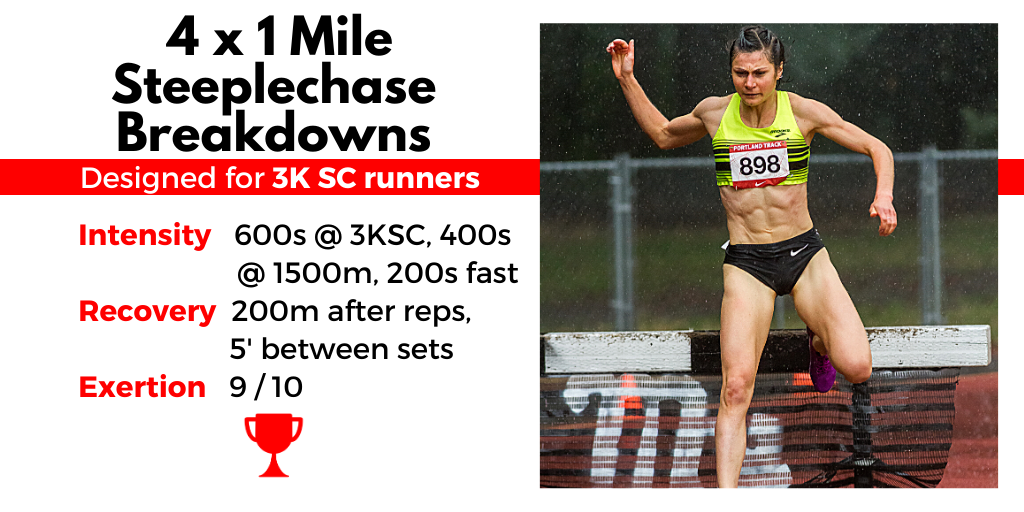4 x 1 Mile Steeplechase Breakdowns
4 x 1 Mile Steeplechase Breakdowns
4 x (600m over hurdles — 400m — 200m)
Designed for 3,000m Steeplechase runners
Intensity
600m over hurdles @ 3K SC Goal pace
400s @ 1500m pace
200m fast
Recovery
200m jog in 60” - 80” after each rep
5 minutes between sets
Exertion
9/10
Periodization
Specific Period, Intensification Block
Context & Details
I think of the steeple as jumping and landing 35 times while accelerating into and out of each barrier. In many ways, it is not a distance race but an acceleration-jumping-endurance contest. Making Steeplechasers the most dynamic and powerful type of distance runners.
Like pole vaulters, steeplers are more reckless personality types. I’ve noticed they thrive on novelty and lots of stimuli. Routine and predictability typically cause boredom.
For those reasons — and others — I like 1 Mile breakdown workouts for steeplechase runners.
A breakdown is a simple workout construction: pick the distance of work you want a set of reps to total — in this case, 1 Mile — then break it down into small segments with different themes or paces. Keep the recovery between reps in a set as short as possible while maintaining the quality of each rep.
Coach Vin Lananna’s training relies heavily on breakdown workouts. And considering the success his runners have enjoyed over the years, this type of workout design has merit in my book.
I never like my steeplechasers navigating barriers when highly fatigued. So I will always have them hurdle workout early in a workout and/or set — never at the end. I see little benefit in practicing sloppy hurdling in a fatigued state, it only invites injury or ingraining poor technique.
This is a pretty hard workout — but the steeplechase is a pretty hard race.
The first 600m over hurdles at 3KSC Goal Pace is an honest, but manageable ask. The 200m recovery afterward is grossly inadequate going into a 400m at 1500m pace. And the final 200m Fast is a near A.U.G. (All You Got) situation.
This design is great for upgrading VO₂ Max, lactate-threshold speed, running economy, speed endurance, and most importantly, muscular strength.
“Strength” is important for all runners, but it is vital to steeplechase success.
Here’s Own Anderson, author of Running Science and Running Form, on why:
Running economy is to a large extent a function of running-specific strength and coordination; the stronger and more coordinated a runner is during the running gait cycle, the better will be his or her economy.
As a runner becomes more coordinated, less energy is wasted on nonproductive, nonpropulsive actions, and the runner begins to function with less energy cost. A runner’s goal is not to expend energy stabilizing an uncoordinated body; optimally, all energy usage should be funneled toward creating forward propulsion.
The strength part of the equation operates as follows: The stronger a runner becomes, the smaller the number of muscle cells that will need to be recruited to run at a specific speed. For the stronger runner, each muscle cell is stronger than it used to be as well, and a reduced total number of cells will be required to keep a runner jetting along at chosen pace. Since fewer cells are employed, less energy is expended, and economy is improved.
The other key factor is that gains in strength and coordination can be very speed-specific. Scientific research reveals that when strength is gained at moderate rates of movement, that gain in strength will usually not translate well to higher speeds. The reason for this is that the nervous system has not learned how to optimally coordinate more difficult, higher-speed movements by controlling the muscular system at slower speeds, and thus it functions suboptimally at higher velocities.
Conversely, science tells us that improving one’s strength at high speeds does translate well to slower speeds. If the nervous system can handle a very difficult task at high speed, it should be able to do the same thing when things gear down.
Continue Learning
Join the Scholar Program for $29 to learn more about successful 3,000m Steeplechase Training and get unlimited access to courses and training programs on middle-distance running.
Good books on 3,000m training
Better Training for Distance Runners by Peter Coe
Winning Running by Peter Coe
Running Science by Own Anderson
Modern Training and Physiology for Middle and Long-Distance Runners by John Davis

